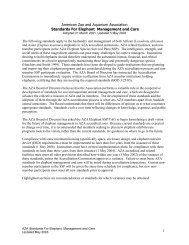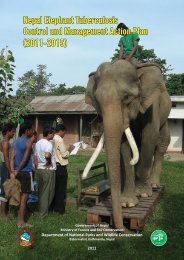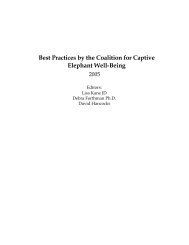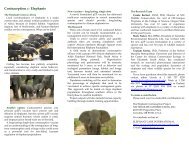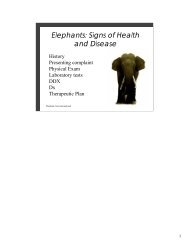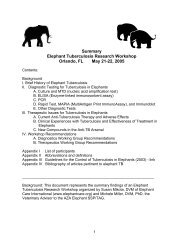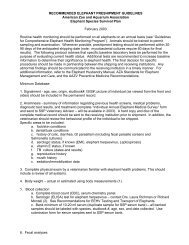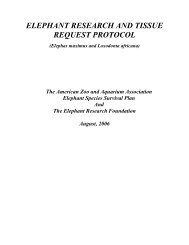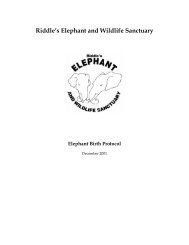Elephants Elephants - Wildpro - Twycross Zoo
Elephants Elephants - Wildpro - Twycross Zoo
Elephants Elephants - Wildpro - Twycross Zoo
- No tags were found...
Create successful ePaper yourself
Turn your PDF publications into a flip-book with our unique Google optimized e-Paper software.
(http://iucn.org/themes/ssc/sgs/afesg/tools/trnsgden.html), Guidelines for thein situ Translocation of the African Elephant for Conservation purposes.DOMESTICATIONCapture of wild elephants for domestic use has become a threat to some wildpopulations. It has been the custom to take wild elephants and train themrather than breed from captive animals. India has banned capture to conservewild herds but hundreds are caught each year in Burma (Myanmar) wherethey are still used in the timber industry (Toke Gale 1974). A ban on loggingin Thailand in 1989 caused a problem with unemployed working elephants,resulting in considerable welfare problems (Mahasavangkul 2001).Working elephants are usually caught between the ages of 15 and 20 whenthey are large enough to work (Cheeran and Poole 1996). Traditional methodsof capture training and taming may involve some cruelty (Fernando 1989)(Alwis 1991). <strong>Elephants</strong> in camps also have a poor record of breeding,probably because of lack of incentive as it is easier to capture older animalsfrom the wild. Thus the capture of wild elephants for domestic use can createboth conservation and welfare problems. (Also see Section 3.1, <strong>Elephants</strong> andMan).DISEASE PROBLEMS IN THE WILDNo comprehensive accounts of the disease problems of wild elephants havebeen published. However disease is not thought to be a major factor affectingelephant populations, and is almost certainly far less significant than theproblems of habitat destruction, elephant-man conflict, poaching, drought etc.The significance of disease will inevitably increase as local populations ofelephants are further reduced in number.Infectious diseases known to affect wild elephants include: anthrax,encephalomyocarditis virus, foot and mouth disease (FMD) and pasteurellosis(known as haemorrhagic septicaemia), (Williams and Barker 2001). Theposition regarding FMD is somewhat confusing. Clinical cases of FMD havebeen reported in captive Asian and African elephants, but African elephantsare generally considered not susceptible under natural conditions (Williamsand Barker 2001). Reports of disease outbreaks in elephants include:cowdriosis (heartwater) a tick borne infection, reported in African elephants;haemorrhagic septicaemia, normally a cattle disease was responsible for thedeaths of several animals in Sri Lanka’s Uda Walawe National Park in May1994 (Kemf and Santiapillai 2000); an outbreak of encephalomyocarditis (theEMC virus which is probably carried by rodent vectors) was reported inAfrican elephant from the Kruger in 1993/4, Asian elephants are alsosusceptible but the mortality is probably not very high (Williams and Barker2001); lymphoid nodules with herpes virus inclusion bodies have been seen inthe lungs of many elephants from the Kruger.Significant parasite infestations do occur in wild elephants, ranging from thecommon elephant louse (Haematomyzus elephantis) to nematodes, trematodes24




